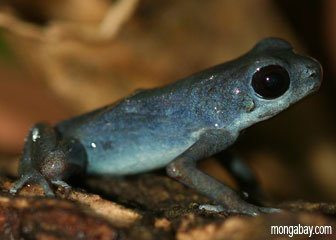Pesticides threaten cloud forests in Costa Rica – new study
Pesticides threaten cloud forests in Costa Rica – new study
mongabay.com
January 21, 2007
Pesticides from coffee and banana cultivation are accumulating in Costa Rica’s biodiverse cloud forests according to research published earlier this month in Environmental Science & Technology (ES&T). The findings have implications for conservation efforts in both the Central American country and in other parts of the world.
The study, led by Frank Wania of the University of Toronto, found that pesticides used in lowland areas are carried by air currents to higher elevations where they are they precipitated out as rain when the air cools. The chemicals — especially insecticide endosulfan and fungicide chlorothalonil — then accumulate in the ecosystem, potentially affecting montane forest biodiversity.
 Photo by Rhett Butler. |
Wania says that the research could help explain the observed decline in amphibian populations, which some scientists have attributed to a parasitic chytrid fungal infection caused by climate change.
“There tends to be a pattern of more extinction at high elevations, which is tricky to explain because most of the human activity is at low elevations,” Wania is quoted in an article appearing on the ES&T’s Research ASAP website. “We might have an explanation, because pesticide concentrations are higher at high altitude.”
Wania and colleagues found that is some areas pesticide levels were “almost an order of magnitude greater on mountains than in low-lying areas closer to plantations” according to Research ASAP.
Further, notes the article, pesticide accumulation in montane forests is not limited to Costa Rica.
“There is a whole series of mountain environments which are going to be susceptible to transport of pesticides,” Research ASAP quotes Crispin Halsall, a scientist from Lancaster University and a co-author of the paper, as saying.
Halsall says that a shift to a new class of pesticides may have worsened pollution in montane forests, in that currently used pesticides are highly water soluble, making them more likely to be dissolved in rain, evaporated, and transported to higher elevations than older organochlorine pesticides.
Further reading: Pesticides waft into pristine rainforests
This article is based on an ES&T Online article by Erika Engelhaupt.